[2022 Vehicle Displays] Desay sv
#Desay #automotive #display

https://ubiresearch.com/en/

https://en.olednet.com/

marketing@ubiresearch.com
+82-2-577-4391
#Desay #automotive #display

https://ubiresearch.com/en/

https://en.olednet.com/

marketing@ubiresearch.com
+82-2-577-4391
At the 28th FINETECH JAPAN held in Makuhari Messe, Japan during December 5-7, 2018, Hiroyuki Hara, manager of Denso said that OLED will be used as future automotive displays due to their various advantages.

Hara refers to the large screen including the touch panel as the latest trend of automobile display, and now LCD is mainly used. However, OLED is expected to be used more and more in automobiles as the automotive electronics makers and drivers demand high-quality displays.
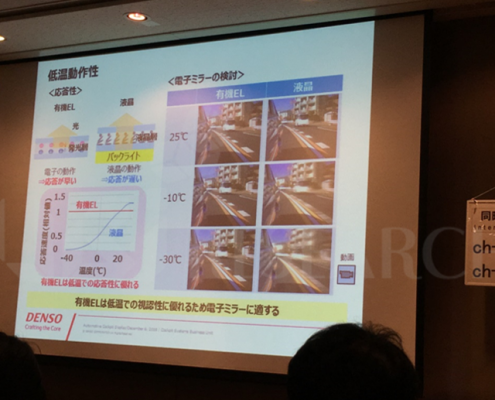
Saying that key elements in automotive displays are high contrast ratio, wide viewing angle, design autonomy, light weight, low reflection and reliability, Hara emphasized that the display that can satisfy all of these key elements is OLED. In addition, the factors related to image quality such as contrast ratio and viewing angle are directly related to safety for the driver. Thus, OLED is to be adopted more. Referring to the requirements of automotive OLED, he finally commented that improving reliability, such as lowering the luminance drop due to temperature changes and preventing damage to OLED due to high humidity, will be key to OLED for its entry into the automotive display market.
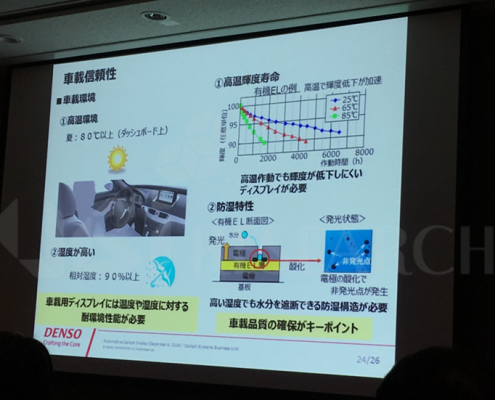
The automotive display is likely to lead the market for next-generation displays following mobile devices and TVs. Various OLED panel makers such as BOE and Visionox, as well as LG Display and Samsung Display, are showing automotive displays at domestic and international exhibitions. Denso also invested Japanese yen 30 billion in JOLED early 2018 to compete with Korean panel makers. Meanwhile, the market for OLED displays for automobiles led by Samsung Display and LG Display is expected to grow to US$ 540 million in 2023 according to UBI Research’s recently published “Automotive OLED Display Report”.
At the 28th FINETECH JAPAN held in Tokyo, Japan from December 5 to 7, 2018, JDI and JOLED announced that they would intensify their cooperation in order to target the middle-sized OLED market.
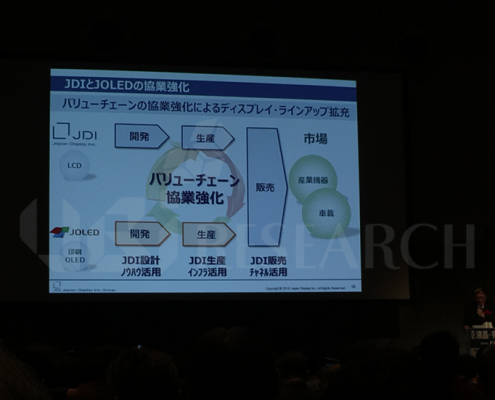
JDI announced that it will actively promote JOLED’s solution process OLED to medium-sized OLED markets such as industrial display markets or automotive display markets through its own design know-how, production infrastructure, and sales channels,.
In particular, JDI announced that it will provide new value to next-generation automotive fields along with JOLED such as support for safety such as electronic mirrors and displays for A/B pillars, new interface functions, movie appreciation using 4-8K displays, and the displays that are harmonized with interior design such as curved surfaces and big screens.
JDI and JOLED also shared booths for exhibition. JOLED introduced 21.6-inch FHD OLED monitors for e-sports and medical applications. In addition, it introduced a number of medium-sized OLEDs such as 12.3-inch HD OLED for automobiles, 12.2-inch FHD flexible OLED, 27-inch 4K OLED for home interior, and 21.6-inch 4K flexible OLED with cylindrical form. It also showcased large OLEDs such as 54.6 inch 4K OLED.
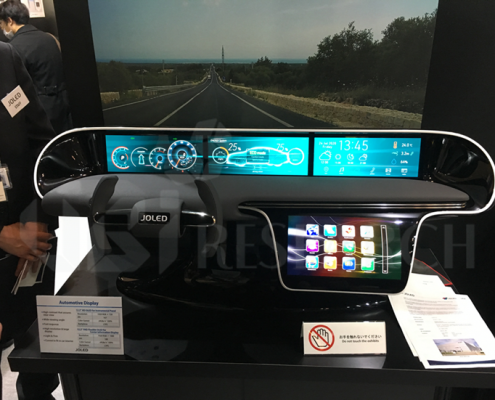
On the other hand, JOLED announced in July, 2018 that it would open its Nomi office for mass production of solution process OLED. Based on 5.5 generation glass substrates, Nomi has production capacity of 20,000 glass substrates per month and plans to mass-produce in 2020.
At IMID 2018 held in BEXCO, Busan on August 29, Kim Kwan-Soo, research fellow of LG Display presented about a new OLED technology for automotive displays.
Kim said that RGB OLEDs applied to mobile devices and WRGB OLEDs applied to TVs do not satisfy customers’ needs in terms of life span. To solve this issue, he introduced 2 stack RGB OLED in which RGB OLED has the same tandem structure as WRGB.
Because 2 stack RGB OLED can be thick due to adding a layer of CCL (charge generation layer) to the multi-layer structure, HTL is made thinner than before and the charge balance of the emitting layer is optimized.

As a result, the 2-stack RGB OLED shows 1.5 ~ 2 times higher emitting efficiency than the 1-stack RGB OLED. Its lifetime is increased by 4 times on T80 basis.
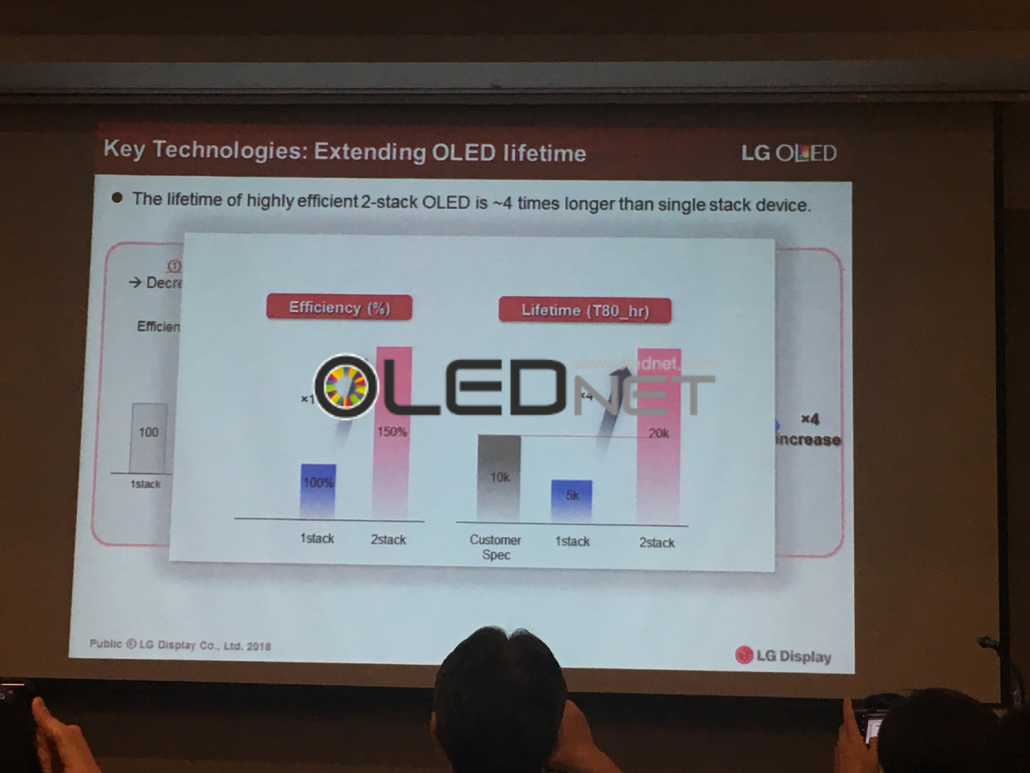
However, the 2-stack structure has a disadvantage in that it has higher power consumption than the general structure. Thus, it is necessary to make efforts to solve this disadvantage.
LG Display and Samsung Display introduced a number of applications using OLED at IMID 2018 held in BEXCO, Busan, drawing attention from many visitors. In particular, LG Display displayed its strategies mostly for large OLED applications such as 77-inch transparent OLED and 55-inch video wall OLED, while Samsung Display introduced the small and medium sized OLED applications mainly for automotive and virtual reality devices.
First, the panel thickness of the 77 inch transparent flexible OLED introduced by LG Display is 400 μm, the bending radius is 80 mm, and the luminance is 200 nit based on full white.
LG Display explained that it would improve the required transmittance and durability. Also, it commented that the goal is to reduce bezel to 0.5 mm at its display of 4 FHD OLEDs with 3.8 mm bezel.
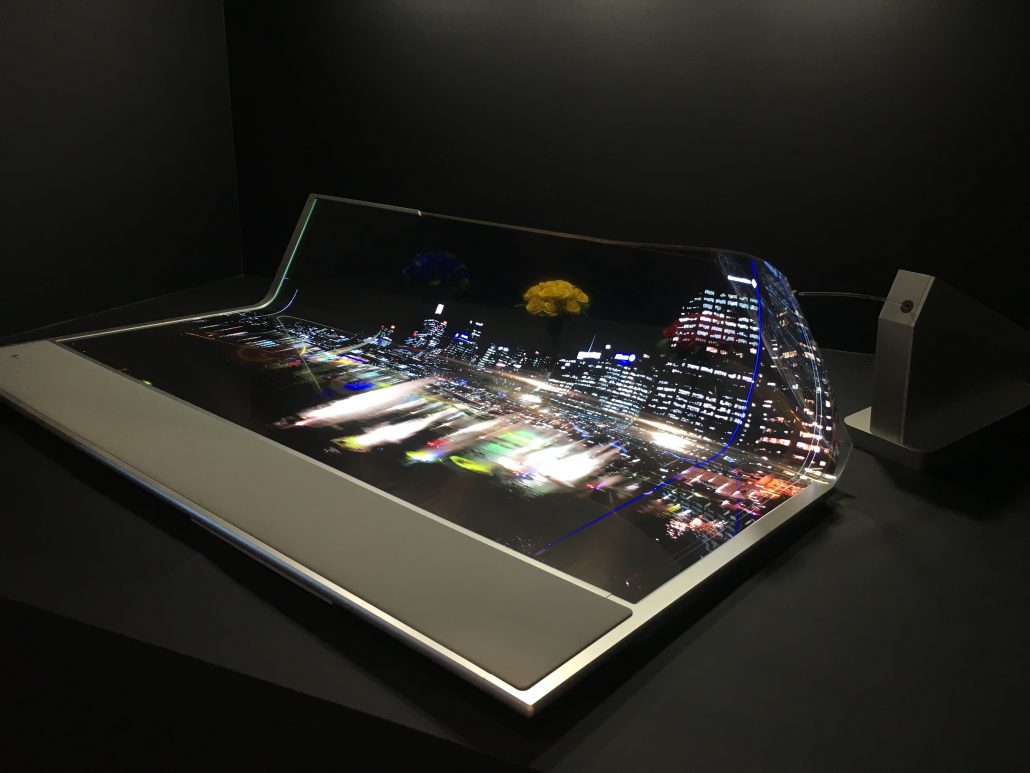
In addition, LG Display presented a 1200ppi 4.3-inch WRGB OLED for virtual reality devices. One official explained that WRGB OLED, which represents the resolution by etching the color filter, would be advantageous for higher resolution than RGB using the deposition method.
Meanwhile, Samsung Display exhibited a number of automotive OLEDs, including unbreakable OLED for 6.22 inch steering wheel, 1000R curved OLED for passenger monitor, transparent OLED for HUD, S-curved OLED for CIO and rollable OLED. The concerned official expects the OLED to be widely applied to inside automobiles because it has excellent design autonomy, compared to LCD.
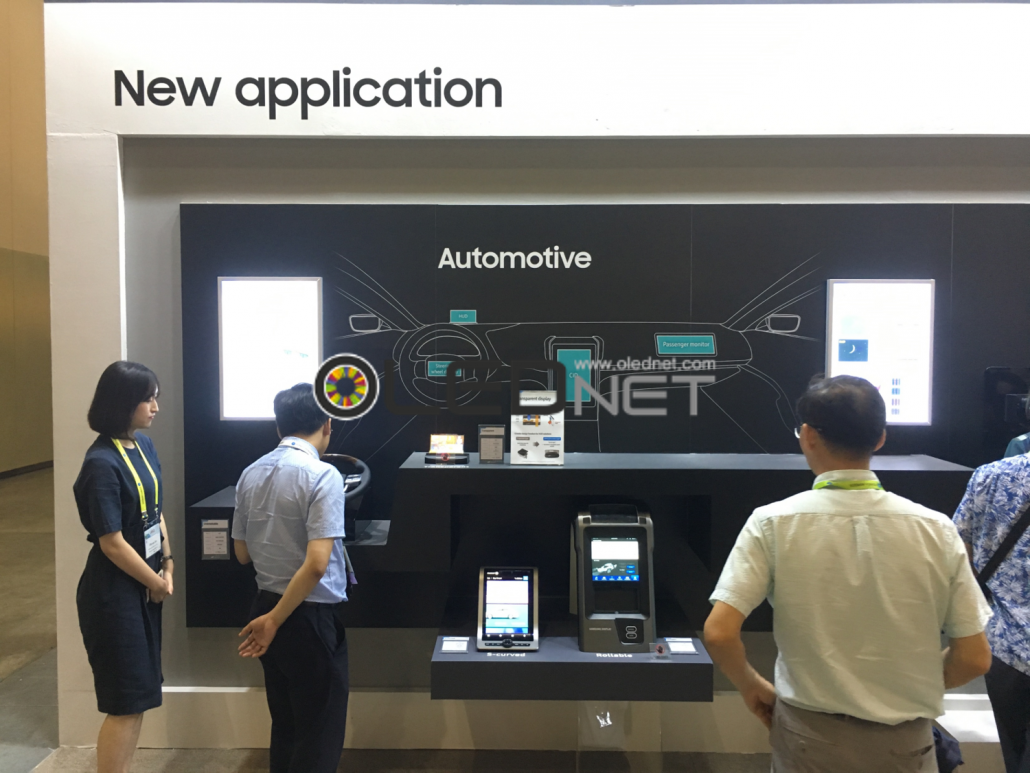
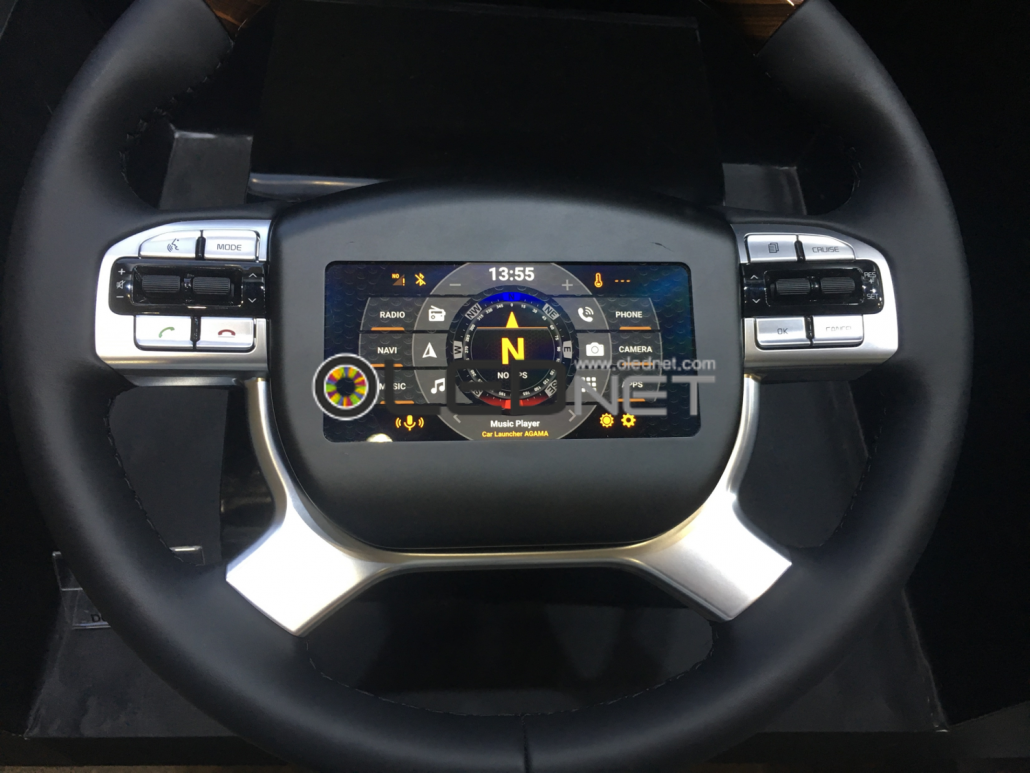
He added “Although there are many things to be improved, such as brightness and reliability, it is continuously improving the required performance through the feedback from European customers”.
Furthermore, Samsung Display showcased light field display and 2,000ppi resolution RGB OLED for virtual reality devices.
■ “Finding a new OLED market” – Discussing OLED replacement in view of OLED application development
■ Discussing new technologies of future display (LCD, QD-LCD, OLED)

The potential of future OLED development is inexhaustible as OLED can be applicable to all industries including VR / AR, automotive, aerospace, and lighting not content with smart phone and TVs. There has been growing public interest in OLED in many different industries. To meet the market demand, Ubi Research, a market research company co-hosts ‘iMiD2017 Industrial Forum’ with Korea Display Society (KIDS) in BEXCO, Busan on 30th of August.
The forum will proceed with a panel discussion among key specialists and presentation, which will enable people from many different industries to exchange information not only on the display market but also current OLED market status, technology and explore a new market potential generated in the future.
In the first session ‘look for a new OLED market’, OLED replacement will be presented in view of OLED application development. The key players include Dr. Teruo Tohma, WooSeok Jeong, principal research fellow at the Electronics and Telecommunications Research Institute (ETRI), Julian K chang, Managing director of Boeing Corporation, Professor TAKUYA KOMODA at Yamagata University, senior researcher, Michi Hisaishi, ALPINE Michihisa Onishi.
The second session, ‘Discussion of New Technologies in Future Display’ will provide insight into the latest products and technology trend of TV manufacturers competing with one another to dominate the next generation display market. Nam-Suk Oh, CEO of Samsung Electronics will present an updated LCD TV using Quantum dots technology under the title of “Quantum Dot and Advance of LCD-TV”.
In the OLED TV camp, under the title of “OLED, Now and Future”, Joon-Young Yang at LG Display will review the current status of OLED TV led by the current market trends, and also address OLED future implemented in a wide range of ‘flexible and rollable’ designs.
Weir Cao, senior researcher at TCL, will present both the technology status of the Colloidal Quantum Dots and TCL products applied to LCD in the market, under the topic of “TCL Display Technology with QDs”. The premium TV strategies are expectedly revealed. Lee Choong-hoon, CEO of Ubi research co-host of this forum, offered a time to summarize the premium TV market on the topic of ‘OLED TV market outlook by premium TV market expansion’ by analyzing the presentations of the companies that presented earlier.
For more information on the 17th iMiD2017 Industrial Forum, please visit iMiD2017 official website (http://imid.or.kr/2017/indi_forum.asp).
Chrysler held an event to introduce its next-generation concept car “POTAL” at the Pre-CES 2017 show, Pre-CES2017Media Event.

Chrysler classified the space where humans will live in the future into three; family, job and vehicle, and named vehicles a “Third Space”. Future drivers can do a variety of activities inside vehicles thanks to autonomous driving.
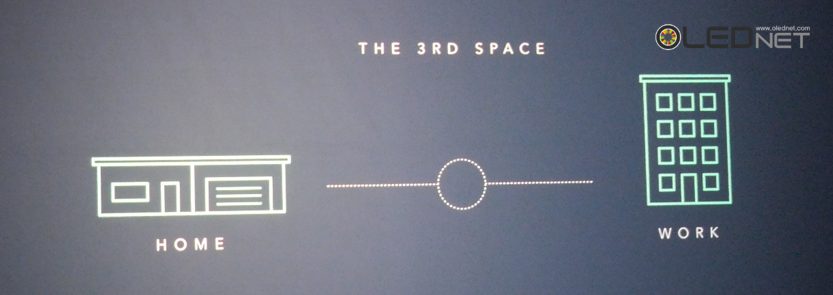
The interior design of “POTAL” is very simply organized. The steering wheel is designed to have storage space in dashboard. The high-mount instrument panel display is positioned on the top of the dashboard to have high visibility. ‘Connected’ interface is applied between display and the surrounding environment including driving information. There is another display underneath the dashboard.
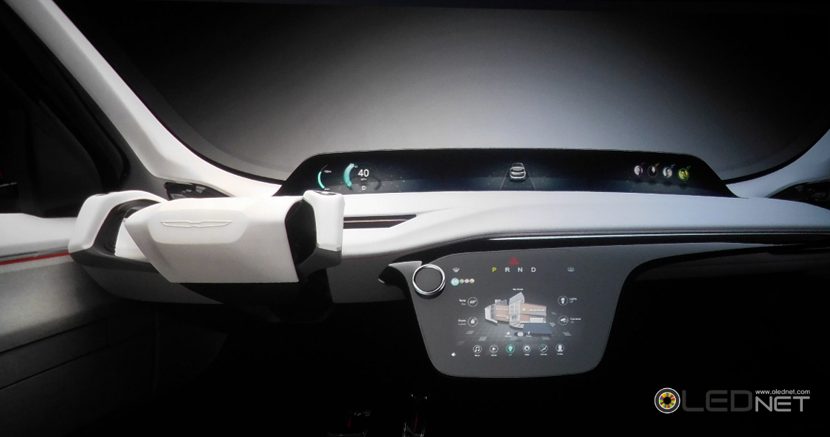
The displays on the interior front of “POTAL” prepared to open the new era of future vehicles consist of AMOLED. A ‘high-mount’ AMOLED display is flexible OLED, and a display underneath is a 12-inch glass AMOLED. Both displays are supplied by Samsung Display.
At many car shows, the concept cars with curved displays have been introduced so far, but this show might be the first time to exhibit flexible OLED directly.


Flexible OLED used for ‘POTAL’ is so reflective to minimize the loss of information against light coming in from the outside, and its background is black to have optimum visibility.
The prestigious automaker and the great OLED manufacturer meet and create a new technology.
Flexible OLED provided by the world’s best mobile display company, Samsung Display is not expected to be used in the f motor industry or a while. Apple will apply flexible OLED to iPhone in earnest, and Samsung Electronics Co., Ltd. will also use flexible OLED entirely for the next-gen Galaxy S8. Accordingly, the on-going flexible OLED line also lacks a capacity to respond to the smartphone market. Samsung Display’s flexible OLED is expected to continue a shortage of supply until 2019 so that the world’s best luxurious instrument panel will be supplied by 2020.
Applications of various lighting such as LED and OLED etc. have been expanded so as to implement unique designs and diversified functions of own brand by each automotive company as well as developments of automotive industry including smart-car and connected-car etc. are being made at the same time. In this regard, Center Head Ju Jae-young of Korea Photonics Technology Institute stated current situation by saying “Lighting for vehicles belongs to the business which expects profitability, but it is not easy for late starters to break in because entry barrier is high from characteristics of automotive industry. Ultimately, whether to stimulate purchase desires is important.” Also, he counted ‘styling possibilities’ as one of successful LED lighting by saying “The reason of getting more popularity of LED than existing halogen and HID is derived from the fact that LED has strong points in designs.”
And then, the Head forecasted like “The exterior deco of lamp market for automobiles overtook the interior deco market from the start of 2013, and 3.1B USB market will be made in 2019 by achieving annual 11.6% growth in average to 2019 from 2014,” and said “The exterior deco market will grow up over 15% annually, and DRL (Daytime Running Lamp) and Head lamp are leading market due to their high growth rates.”
Besides, Center Head Ju Jae-young stated “In order to enter market by OLED, it has to stimulate purchase desires with new designs which do not substitute LED simply,” and added “There are possibilities if designs are unique, and stimulate sensitivity like Fun- VII concept car of Toyota or lighting of Chrysler having been disclosed to the public in 2013.”
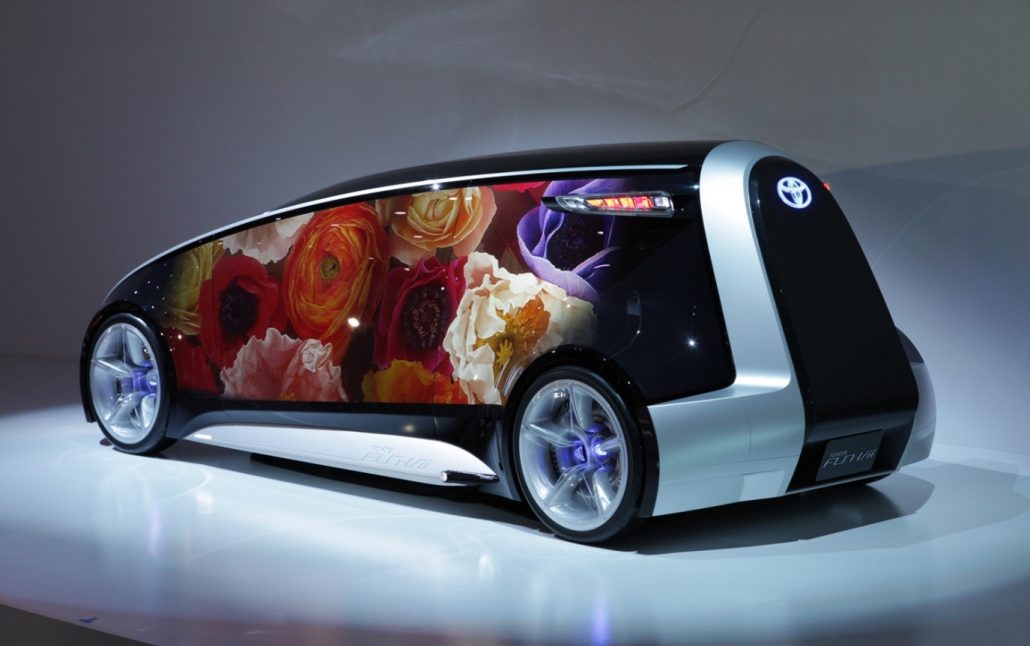
<Fun Vii Concept Car of Toyota Source: Toyota official homepage>
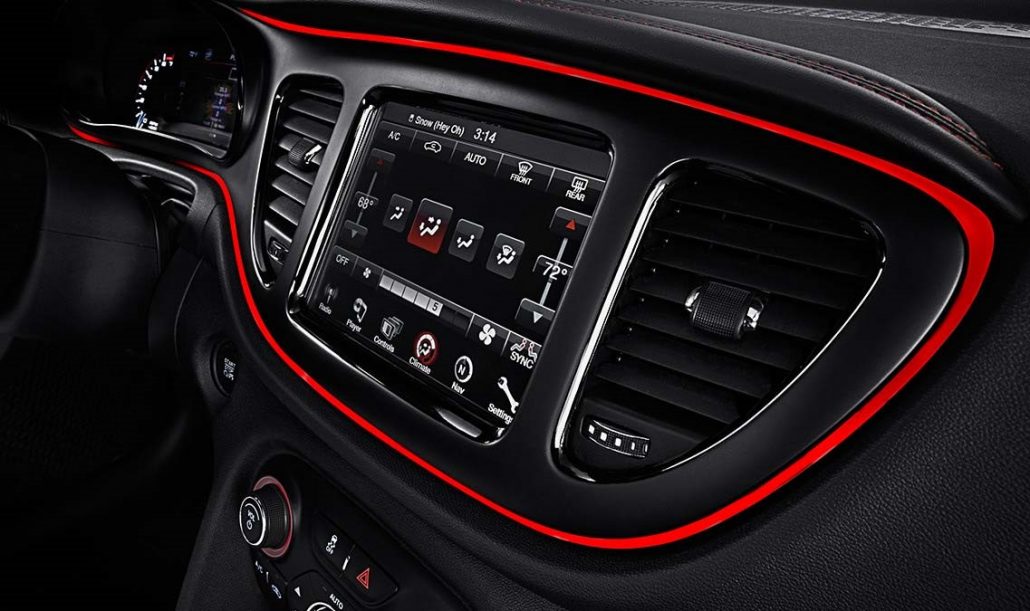
<Floating island bezel unveiled from Chrysler, Source: www.metrododgedeals.com>
Like this, OLED is thin, light and can be bended characteristically, and has strong points such like free designs are available, so it is getting a lot of interests as next-generation illuminants including indoor lighting etc. as well as lighting for vehicles. According to 2016 OLED lighting annual report having been published in August 2016 by UBi RESEARCH, it explains that OLED lighting is known to display same performance with LED in R&D levels regarding characteristics of brightness and lifetime etc. as eco-friendly lighting and having high energy-efficiency, thus OLED seems to have sufficient competitiveness only if requested brightness is satisfied along with each automotive company.
Display market for global automobiles has continued stable growth of approximately 10% yearly recently, and LG Display and Samsung Display do not save investments by paying attention to it as new application. In this regard, Senior Researcher Yang Seong-jin of LG Economic Research Institute lighted up the entry reason of display for automobiles such like creating effects of new revenue are anticipated.
Senior Researcher Yang said “Display market for automobiles has 10% volume of the whole display market and belongs to 2% levels of total cost, but automotive industry has been developed steadily through smart-car and connected-car etc. In contrast, display market has been withered gradually, and panel prices are being lowered continuously, and thus it is directly connecting to survival matters actually.” While stating display market for automobiles as an alternative for this problem, he revealed the reason by saying “The number of participating companies is a few, and average price of display panels for automobiles to which thorough commercialization is required is higher than mobile phone or tablet pc two or three times.”
In display market for automobiles, Innolux and AUO, CPT, Japan display, Sharp occupied about 70% of total market based on 2015 sales of Taiwan, and LG Display recorded 10% share uniquely in domestic, but Samsung Display, second mover, failed in entering ranks. However, LG Display announced a plan that they were planning to enter the market with POLED to which flexible function was available after having designated display for automobiles as a promotion business, and Samsung Display was known to set up a policy of progressing differentiation strategies on display for automobiles based on small& medium OLED technology, so market share is expected to be increased little by little.
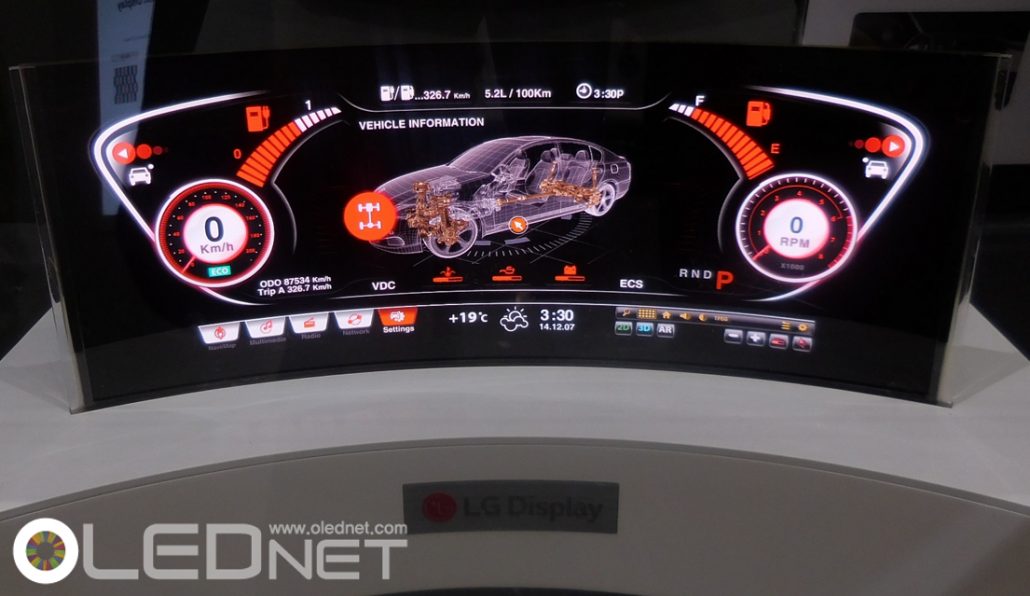
<LG Display/Flexible Automotive Display, SID 2015>
In the display market having been stagnated currently, concentration on display market for automobiles would be resultantly necessary for high profits, and OLED panel could get opportunities of creating new revenue sources by overpassing mobile and tablet pc market, if OLED panel solves demanding requirements of display for automobiles.
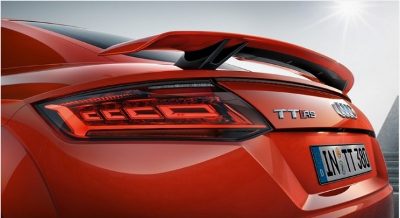
With the Forecast of Continued growth of OLED Lighting Panel Market, Automotive Lighting Market is Rapidly Growing ( Picture Source = Novaled )
UBI RESEARCH / CEO:Choong Hoon Yi / Business License Registration Number 220-87-44660
ADDRESS: A-1901, Samho Moolsan Bldg, 83, Nonhyeon-ro, Seocho-gu, Seoul, Republic of Korea (Zip) 06775 TEL:+82-2-577-4390 / E-MAIL:marketing@ubiresearch.com
